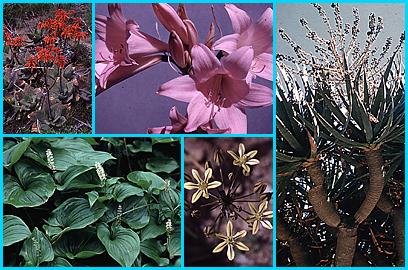
The Asparagales include nearly 5000 species of agaves, aloes, onions, day-lilies and related plants. As such, they are one of the most structurally diverse groups of monocots, ranging from small herbs to flowering Agaves that may reach more than ten meters in height. They provide us with asparagus, onion, and garlic, as well as many garden plants, such as daffodils. Agave was of particular importance to the Aztecs, supplying fibers for instruments and paper, as well as the drink now called tequila.

The picture above shows some of the structural and taxonomic diversity in the Asparagales. The plants shown are (clockwise, from upper left): Aloe saponaria growing in La Jolla, California; Amaryllis, a common ornamental; Dracaena draco, a sizeable tree on the Canary Islands; Triteilia, a relative of the onion; and Maianthemum dilatatum, an understory herb growing in northern California. All pictures courtesy of the Jepson Herbarium.
Most members of the Asparagales produce a tight cluster of leaves at the base of the plant or on top of a squat trunk; from the top of this, a long stalk develops bearing the flowers. A few members, such as Asparagus and Solomon's seal have leaves attached along the stem.
A permineralized fossil plant called Protoyucca is known from the Miocene of northwestern Nevada. Its vascular structure and secondary growth are not unlike those found in the Joshua tree (Yucca brevifolia).
The Aspragales have been lumped into the Liliales since the beginning of this century, though they share no synapomorphies with that group. They have recently been removed again, and are now distinguished (mostly) by the presence of a layer of phytomelanin around their seeds. This appears as a papery "sooty" black layer over the seed.
For more information about the Asparagales, try the DELTA descriptions for the Agavaceae, Alliaceae, Amaryllidaceae, Anthericaceae, Aphyllanthaceae, Asparagaceae, Asphodelaceae, Asteliaceae, Blandfordiaceae, Calectasiaceae, Convallariaceae, Cyanastraceae, Dasypogonaceae, Doryanthaceae, Dracaenaceae, Eriospermaceae, Hanguanaceae, Hemerocallidaceae, Herreriaceae, Hostaceae, Hyacinthaceae, Hypoxidaceae, Ixioliriaceae, Luzuriagaceae, Nolinaceae, Philesiaceae, Phormiaceae, Ruscaceae, Tecophilaeaceae, Velloziaceae, and the Xanthorrhoeaceae
Learn about the relationships of Agavaceae and other closely allied families. You can view images of Agavaceae at Texas A&M Botany. They also have images of the Amaryllidaceae and Hemerocallidaceae listed under the Liliaceae. View images of Malagasy Dracaenaceae at the Missouri Botanical Garden
Check out the information about Yucca and other vegetation of the Eastern Mojave provided by Tom Schweich or scan through the visitor information for Joshua Tree National Monument or try this page for information about the Park.
Horticultural information is available from the Friends of the Dayliliy (Hemerocallis), or at The Haworthia Page maintained by the British Cactus and Succulent Society

W. D. Tidwell and L. R. Parker. 1990. Protoyucca shadishii gen. et sp. nov., and arborescent monocotyledon with secondary growth from the Middle Miocene of northwestern Nevada, USA. Rev. Palaeobot. Palynol. 62: 79-95.

